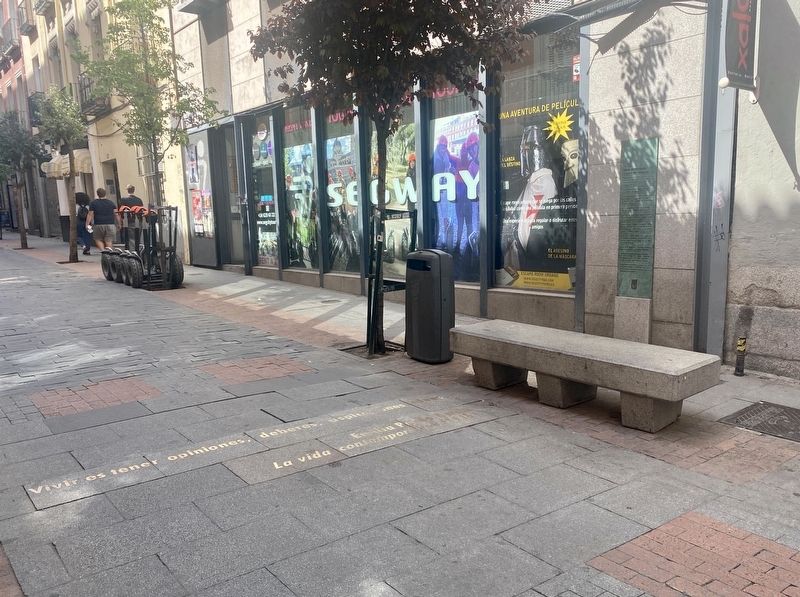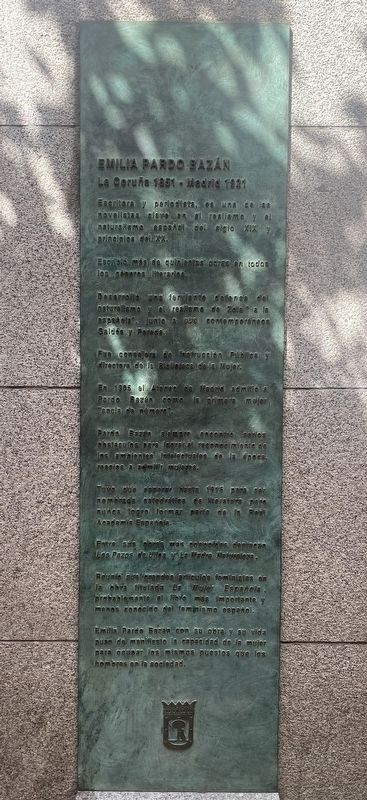Cortes in Madrid, Spain — Southwestern Europe (Iberian Peninsula)
Emilia Pardo Bazán (La Coruña 1851 - Madrid 1921)
Escritora y periodista, es una de las novelistas clave en el realismo y el naturalismo español del siglo XIX y principios del XX.
Escribió más de quinientas obras en todos los géneres literarios.
Desarrolló una ferviente defensa del naturalismo y el realismo de Zola ”a la española", junto a sus contemporáneos Galdós y Pereda.
Fue consejera de Instrucción Pública y directora de la Biblioteca de la Mujer.
En 1905 el Ateneo de Madrid admitió a Pardo Bazan como la primera mujer "socia de número".
Pardo Bazán siempre encontró serios obstáculos para lograr el reconocimiento de los ambientes intelectuales de la época, reacios a admitir mujeres.
Tuvo que esperar hasta 1916 para ser nombrada catedrática de literatura pero nunca logro formar parte de la Real Academia Española.
Entre sus obras más conocidas destacan Los Pazos de Ulloa y La Madre Naturaleza.
Reunió sus grandes articulos feministas en la obra titulada La Mujer Española, probablemente el libro más importante y menos conocido del feminismo español.
Emilia Pardo Bazán con su obra y su vida puse de manifiesto la capacidad de la mujer para ocupar los mismos puestos que les hombres en la sociedad.
Writer and journalist, she was one of the key novelists in Spanish realism and naturalism in the 19th and early 20th centuries.
She wrote more than five hundred works in all literary genres.
She developed a fervent defense of Zola's naturalism and realism "a la espanola", along with her contemporaries Galdós and Pereda.
She was a counselor for Public Instruction and director of the Women's Library.
In 1905 the Ateneo de Madrid admitted Pardo Bazán as the first woman "number member".
Pardo Bazán always found serious obstacles to gain recognition from the intellectual circles of the time, reluctant to admit women.
She had to wait until 1916 to be appointed professor of literature, but she never managed to join the Royal Spanish Academy.
Among her best-known works, Los Pazos de Ulloa and La Madre Naturaleza stand out.
She brought together her great feminist articles in the work entitled La Mujer Española ("The Spanish Woman"), probably the most important and least known book on Spanish feminism.
With her work and her life, Emilia Pardo Bazán highlighted the ability

Photographed By Andrew Ruppenstein, April 18, 2022
2. Emilia Pardo Bazán (La Coruña 1851 - Madrid 1921) Marker - wide view
In the street is visible a quote by Pardo Bazán from La Vida Contemporánea: "Vivir es tener opiniones, deberes, aspiraciones, ideas..." - "To live is to have opinions, duties, aspirations, ideas..."
Erected by Ayuntamiento de Madrid.
Topics. This historical marker is listed in these topic lists: Arts, Letters, Music • Women. A significant historical date for this entry is May 12, 1921.
Location. 40° 24.813′ N, 3° 41.894′ W. Marker is in Madrid. It is in Cortes. Marker is on Calle de las Huertas, on the left when traveling east. Touch for map. Marker is at or near this postal address: Calle de las Huertas 39, Madrid 28014, Spain. Touch for directions.
Other nearby markers. At least 8 other markers are within walking distance of this marker. Elena Fortún (a few steps from this marker); Francisco de Quevedo y Villegas (a few steps from this marker); Daniel Urrabieta Vierge (1851 - 1904) (a few steps from this marker); Ricardo Becerro de Bengoa (within shouting distance of this marker); Miguel de Cervantes Saavedra (within shouting distance of this marker); Marcelino Menendez y Pelayo (within shouting distance of this marker); José Echegaray (within shouting distance of this marker); María de Zayas Sotomayor (within shouting distance of this marker). Touch for a list and map of all markers in Madrid.
Also see . . . Emilia Pardo Bazán (Wikipedia).
Excerpt: Emilia Pardo Bazán y de la Rúa-Figueroa (16 September 1851 – 12 May 1921), countess of Pardo Bazán, was a Spanish novelist, journalist, literary critic, poet, playwright, translator, editor and professor. She is known for introducing naturalism into Spanish literature, for her detailed descriptions of reality, and for her ground-breaking introduction of feminist ideas into the literature of her era. Her ideas about women's rights for education also made her a prominent feminist figure.(Submitted on October 28, 2022.)
Credits. This page was last revised on February 2, 2023. It was originally submitted on October 28, 2022, by Andrew Ruppenstein of Lamorinda, California. This page has been viewed 67 times since then and 10 times this year. Photos: 1, 2. submitted on October 28, 2022, by Andrew Ruppenstein of Lamorinda, California.
